Searching for best SEO tools? You are at the right place. In the ever-evolving landscape of digital marketing, Search Engine Optimization (SEO) remains a cornerstone for enhancing online visibility and driving organic traffic. On-page SEO, a critical aspect of this strategy, focuses on optimizing individual web pages to rank higher in search engine results. To achieve this, leveraging the power of on-page SEO tools is indispensable. In this blog post, we’ll delve into the world of on-page SEO tools, discussing their significance and highlighting some essential tools that can help propel your website’s success.
Why On-Page SEO Matters

On-page SEO involves fine-tuning various elements within a web page to align with search engine algorithms. This practice not only improves search engine rankings but also enhances user experience, leading to higher engagement and conversion rates. By optimizing factors such as keywords, content quality, meta tags, internal linking, and more, your website becomes more appealing both to search engines and human visitors.
The Role of On-Page SEO Tools
In today’s competitive digital landscape, relying solely on manual techniques is no longer practical. On-page SEO tools offer efficiency, accuracy, and insights that can significantly boost your optimization efforts. These tools aid in keyword research, content analysis, technical auditing, and tracking performance, enabling marketers to make informed decisions and stay ahead of the curve.
Why Use OnPage SEO Tools?
Using an On-Page SEO tool offers several benefits that can significantly enhance your website’s search engine visibility, user experience, and overall digital marketing efforts.
Here are some compelling reasons to use an On-Page SEO tool:
- Improved Search Engine Rankings: On-Page SEO tools help you optimize your content to align with search engine algorithms. By following their recommendations, you increase the likelihood of your pages ranking higher in search engine results.
- Enhanced Organic Traffic: Better search engine rankings lead to increased organic traffic to your website. Optimized pages are more likely to attract clicks from users searching for relevant keywords.
- Better User Experience: On-Page SEO involves optimizing elements such as content quality, readability, and page speed. A well-optimized page provides a positive user experience, leading to lower bounce rates and increased engagement.
- Keyword Targeting: These tools help you identify and target relevant keywords that your audience is searching for. Proper keyword optimization ensures that your content reaches the right audience.
- Content Quality: On-Page SEO tools analyze your content’s quality and relevance. This helps you create valuable, informative, and engaging content that resonates with both users and search engines.
- Technical Optimization: Many tools perform technical audits to identify issues like broken links, duplicate content, and poor site structure. Fixing these issues improves site functionality and SEO performance.
- Time Efficiency: On-Page SEO tools automate the process of analyzing and suggesting improvements, saving you time compared to manual analysis.
- Real-Time Recommendations: These tools offer real-time suggestions as you create or edit content. This immediate feedback ensures that you’re optimizing content effectively as you go.
- Competitive Analysis: Some tools provide insights into your competitors’ strategies, helping you identify opportunities to outperform them in search rankings.
- Data-Driven Decisions: On-Page SEO tools provide data and insights that guide your optimization efforts. This data-driven approach allows you to make informed decisions based on actual performance metrics.
- Algorithm Updates: Search engine algorithms are constantly evolving. On-Page SEO tools keep up with these changes and offer recommendations that align with the latest best practices.
- Reporting and Tracking: Many tools offer reporting features that allow you to track your progress over time. This helps you measure the impact of your optimization efforts and adjust strategies accordingly.
- Continuous Optimization: On-Page SEO is an ongoing process. These tools help you regularly review and optimize your content, ensuring that your website remains competitive in the ever-changing digital landscape.
In essence, On-Page SEO tools are invaluable for ensuring that your website’s content is optimized to meet both user needs and search engine requirements. By utilizing these tools, you can drive more organic traffic, improve user engagement, and ultimately achieve your digital marketing goals more effectively.
Also Read: Best SEO Tools With FREE Trial
Essential On-Page SEO Tools

- Yoast SEO: This WordPress plugin is a favorite among content creators and marketers for its user-friendly interface and comprehensive on-page analysis. Yoast SEO provides real-time suggestions for optimizing content, including keyword density, meta descriptions, readability, and more.
- Moz Pro: With a suite of SEO tools, Moz Pro is a one-stop solution for on-page optimization. Its “Page Optimization” feature offers actionable insights, highlighting areas for improvement and guiding users to create search-friendly content.
- SEMrush: Beyond its robust keyword research capabilities, SEMrush offers on-page SEO tools that assist in tracking rankings, analyzing backlinks, and optimizing content for better performance. Its content template feature provides valuable recommendations based on top-ranking competitors.
- Screaming Frog SEO Spider: This desktop tool is indispensable for technical on-page SEO. It crawls websites and provides an in-depth analysis of on-page elements, including metadata, headers, and internal links, helping identify and rectify technical issues.
- Google Search Console: A free tool by Google, Search Console aids in monitoring a website’s performance in search results. It provides insights into search queries, click-through rates, and indexing issues, allowing you to fine-tune your on-page strategies.
- Ahrefs: Renowned for its backlink analysis, Ahrefs also offers on-page SEO features. Its “Content Explorer” helps identify popular content in your niche, while the “Site Audit” tool evaluates technical aspects for optimal on-page performance.
Features an OnPage SEO tool Must Have
An effective On-Page SEO tool should have a range of features that help you optimize your website’s individual pages for better search engine visibility and user experience.
Here are some essential features that an On-Page SEO tool should have:
- Keyword Analysis: The tool should provide insights into keyword usage, density, and relevance on your web pages. It should help you identify primary and secondary keywords for optimization.
- Content Analysis: Evaluate the quality, relevance, and uniqueness of your content. Check for keyword placement, content length, and readability to enhance user engagement.
- Meta Tags Optimization: Assist in optimizing meta titles and meta descriptions for each page, ensuring they are within character limits, compelling, and include relevant keywords.
- Header Tags Analysis: Identify proper usage of H1, H2, H3, and other header tags to structure content and improve readability.
- Internal and External Link Analysis: Examine internal linking structures and suggest opportunities for improved navigation. Check external links for relevance and authenticity.
- Image Optimization: Analyze image alt attributes, file sizes, and loading times for SEO and user experience optimization.
- Page Speed Insights: Provide recommendations to improve page loading speed, which is crucial for both user experience and search engine rankings.
- Mobile-Friendly Analysis: Evaluate how well your pages perform on mobile devices and offer suggestions for mobile optimization.
- Readability Assessment: Help improve the readability of your content by providing insights on sentence structure, paragraph length, and use of subheadings.
- Duplicate Content Detection: Detect duplicate content issues that might harm your SEO efforts and provide suggestions for resolving them.
- Canonicalization: Assist in implementing canonical tags to prevent duplicate content issues and consolidate ranking signals.
- Schema Markup Suggestions: Offer guidance on implementing structured data markup to enhance search results with rich snippets.
- Social Sharing Optimization: Provide recommendations for optimizing how your content appears when shared on social media platforms.
- Competitor Analysis: Compare your on-page SEO efforts with those of your competitors, highlighting areas for improvement and identifying strengths.
- User Experience Recommendations: Offer suggestions to improve user experience, including calls-to-action, engagement elements, and clear navigation.
- Reporting and Tracking: Generate reports that show the progress of your on-page optimization efforts over time, allowing you to measure the impact of your changes.
- Customization: Allow customization of settings and preferences based on your specific website’s needs.
- User-Friendly Interface: Provide an intuitive and easy-to-use interface that enables users with varying levels of SEO knowledge to effectively use the tool.
- Regular Updates: Stay up-to-date with search engine algorithms and best practices to ensure that the tool’s recommendations are current and relevant.
Remember that the best On-Page SEO tool is one that aligns with your specific needs and workflow. Evaluating different tools based on these essential features will help you make an informed choice for optimizing your website’s on-page SEO efforts.
Technical Elements of an OnPage SEO Audit

An On-Page SEO audit is a comprehensive analysis of your website’s individual pages to ensure they are optimized for search engine visibility, user experience, and conversion.
Here are the key elements that a thorough On-Page SEO audit should include:
- Keyword Analysis:
- Evaluate keyword usage, density, and relevance on each page.
- Identify primary and secondary keywords for optimization.
- Content Quality and Relevance:
- Assess the quality, uniqueness, and relevance of the content.
- Ensure content addresses user intent and provides value.
- Title Tags and Meta Descriptions:
- Review title tags and meta descriptions for length, clarity, and inclusion of target keywords.
- Ensure they accurately represent the page’s content and entice clicks.
- Header Tags and Content Structure:
- Check proper usage of H1, H2, and other header tags.
- Ensure content is well-structured with appropriate headings.
- Keyword Placement:
- Analyze keyword placement in headings, paragraphs, and other content elements.
- Avoid keyword stuffing and maintain natural flow.
- Internal and External Links:
- Review internal links for relevance and structure.
- Check external links for authority and relevance to the topic.
- Image Optimization:
- Assess image alt attributes for accuracy and keyword relevance.
- Optimize image file sizes for faster page loading.
- Mobile-Friendly and Responsive Design:
- Ensure pages are mobile-friendly and responsive across devices.
- Check for elements that might cause usability issues on mobile.
- Page Speed and Loading Times:
- Analyze page speed and loading times using tools like Google PageSpeed Insights.
- Optimize images, minimize scripts, and leverage browser caching to improve speed.
- Canonicalization and Duplicate Content:
- Implement canonical tags to avoid duplicate content issues.
- Check for duplicate content across pages and address them.
- Schema Markup:
- Evaluate the use of structured data (schema markup) to enhance search results with rich snippets.
- Implement schema markup to provide additional context to search engines.
- User Experience and Readability:
- Assess the readability of content using readability tools.
- Ensure content is easy to understand and engage with.
- Page URLs:
- Review URLs for clarity, conciseness, and inclusion of keywords.
- Use descriptive URLs that accurately reflect the content’s topic.
- Meta Robots Tags:
- Verify that pages are properly indexed and not blocked by meta robots tags.
- Use noindex, nofollow tags as needed to prevent indexing of certain pages.
- Conversion Elements:
- Evaluate the presence of conversion elements such as calls-to-action, forms, and contact information.
- Optimize these elements for higher conversion rates.
- Social Sharing Optimization:
- Review how pages appear when shared on social media platforms.
- Optimize Open Graph and Twitter Card metadata for better sharing.
- Technical Issues:
- Identify technical issues such as broken links, 404 errors, and server errors.
- Ensure proper redirection for broken links.
- Analytics and Tracking:
- Verify that analytics and tracking codes are correctly implemented.
- Use tools like Google Analytics to monitor user behavior and traffic sources.
- Accessibility and Indexing:
- Ensure that search engines can access and index your content.
- Check for issues that might prevent crawling or indexing.
- Local SEO (if applicable):
- Optimize pages for local search if your business has a physical location.
- Include NAP (Name, Address, Phone Number) information consistently.
- Reporting and Documentation:
- Generate a comprehensive audit report that includes findings, recommendations, and action items.
- Document the changes you make based on the audit to track improvements over time.
Some of the OnPage SEO Tools That SEO Experts Use & Recommend
1: YOAST SEO Tool & How to Use it for Best OnPage SEO Result
Yoast SEO is a widely popular WordPress plugin that offers a range of features to help optimize your on-page SEO efforts. It provides real-time analysis and suggestions while you create or edit content, ensuring that your web pages are well-optimized for search engines. Here’s how to use Yoast SEO for the best on-page SEO results:
Step 1: Install and Activate Yoast SEO Plugin
- Log in to your WordPress dashboard.
- Navigate to “Plugins” and click on “Add New.”
- Search for “Yoast SEO” and install the plugin.
- Activate the plugin once it’s installed.
Step 2: Configure Basic Settings
- After activation, you’ll see a new “SEO” tab in your WordPress dashboard. Click on “SEO” and then “General” to access the plugin’s general settings.
- Follow the prompts to configure your site’s settings. This includes features like SEO visibility, company information, and webmaster verification.
Step 3: Use Yoast SEO for Content Optimization
- When you create or edit a post or page, scroll down to the Yoast SEO section.
- Focus Keyword: Enter the primary keyword you want the page to rank for. This helps Yoast SEO analyze your content’s optimization.
- SEO Analysis: Yoast will provide real-time analysis and suggestions based on your focus keyword. It evaluates factors like keyword density, meta tags, content length, readability, internal and external links, and more.
- Readability Analysis: Yoast also assesses the readability of your content, providing suggestions to improve user experience.
- Meta Title and Meta Description: These are what appear in search results. Yoast will show you how your title and description will look and provide guidelines for optimizing them.
Step 4: Optimize Content Based on Yoast Suggestions
- Pay attention to the feedback and suggestions provided by Yoast.
- Green Bullet: Aim to turn the bullet next to the focus keyword to green, indicating that your content is well-optimized for that keyword.
- Orange and Red Bullets: These indicate areas that need improvement. Click on them for specific recommendations.
Step 5: Utilize Additional Features
- Cornerstone Content: Yoast allows you to mark certain content as cornerstone content, indicating its importance. This can enhance your site’s internal linking structure.
- Social Integration: Yoast provides options to control how your content appears on social media platforms when shared.
- XML Sitemaps: Yoast generates XML sitemaps that help search engines understand the structure of your site and index your pages effectively.
- Advanced Settings: For more experienced users, Yoast offers advanced settings for certain aspects of your content, such as canonical URLs and breadcrumbs.
Step 6: Review and Update Old Content
Don’t forget to revisit and update older content using Yoast SEO. Improving old posts and pages can lead to increased search visibility.
Step 7: Regularly Update the Plugin
- Ensure that you’re using the latest version of Yoast SEO to access new features and improvements.
2: Moz Pro OnPage SEO tool & How to Use It
Moz Pro offers a suite of SEO tools, including an On-Page SEO tool, to help you optimize your website’s content for better search engine rankings and user experience. Here’s a step-by-step guide on how to use Moz Pro’s On-Page SEO tool effectively:
Step 1: Sign In to Moz Pro
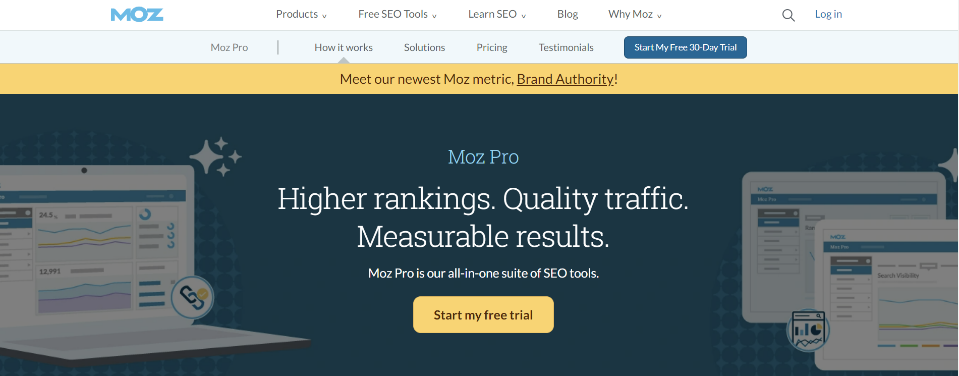
Log in to your Moz Pro account. If you don’t have an account, you’ll need to sign up for a subscription.
Step 2: Access the On-Page SEO Tool
Once you’re logged in, navigate to the “On-Page & Site Crawl” section. This is where you’ll find the On-Page SEO tool.
Step 3: Create a New On-Page Grader Campaign
- Click on “Create a New Campaign” to set up a new On-Page SEO campaign.
- Enter your website’s URL and select the campaign settings, including the region you’re targeting and the search engine you want to focus on.
Step 4: Wait for the Analysis to Complete
- Moz Pro will start analyzing your website’s pages based on the campaign settings. The analysis includes factors like page title, meta description, on-page content, keyword usage, and more. The time it takes will depend on the size of your website.
Step 5: Review the On-Page Recommendations
- Once the analysis is complete, you’ll be presented with a list of pages from your website along with their corresponding on-page analysis.
- For each page, you’ll see an On-Page Score, which indicates how well the page is optimized. You’ll also see recommendations for improvement under each page.
Step 6: Explore On-Page Elements and Recommendations
- Click on a specific page to view detailed recommendations. You’ll find insights on elements such as title tags, meta descriptions, header tags, keyword usage, internal and external links, and more.
- Review the recommendations provided by Moz Pro and consider making changes to your content accordingly.
Step 7: Implement Recommendations
- Work through the recommendations for each page, making necessary changes to optimize your on-page elements.
- Follow best practices for on-page SEO, such as using relevant keywords naturally, creating informative and engaging content, and optimizing meta tags.
Step 8: Monitor Progress
After implementing the recommendations, you can re-run the analysis to see how your pages’ On-Page Scores have improved. Regularly monitoring your on-page optimization efforts will help you track progress and make adjustments as needed.
Step 9: Utilize Additional Moz Pro Features
Moz Pro offers a range of additional features, including site audits, keyword research, backlink analysis, and more. Utilize these tools to enhance your overall SEO strategy.
Step 10: Continuous Optimization
On-page SEO is an ongoing process. Regularly use Moz Pro’s On-Page SEO tool to analyze and optimize new and existing content as search algorithms and user behavior evolve.
3: SEMrush Onpage SEO Tool & How to use Semrush for OnPage SEO Audit
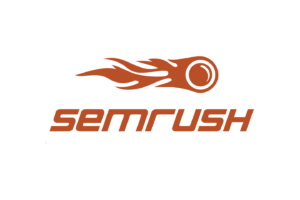
SEMrush offers a comprehensive On-Page SEO tool that can help you analyze and optimize your website’s content for better search engine rankings. Here’s a step-by-step guide on how to use SEMrush for an On-Page SEO audit:
Step 1: Log in to SEMrush

Log in to your SEMrush account. If you don’t have an account, you’ll need to sign up for a subscription.
Step 2: Access the On-Page SEO Tool

Once you’re logged in, navigate to the “On-Page & Tech SEO” section. This is where you’ll find the On-Page SEO tool.
Step 3: Set Up an On-Page SEO Audit
- Click on the “On-Page SEO Checker” option.
- Enter the URL of the page you want to audit and the target keyword you want to optimize for. SEMrush will analyze the page based on this keyword.

Step 4: Wait for the Analysis to Complete
SEMrush will start analyzing the page’s on-page elements, content, and keywords. This may take a few moments, depending on the complexity of the page.
Step 5: Review the Audit Results
Once the analysis is complete, you’ll be presented with a detailed report that includes an On-Page SEO score and recommendations for improvement.
Step 6: Explore Audit Recommendations
Review the recommendations provided by SEMrush. These may include optimizing meta tags, improving content, adding relevant keywords, and enhancing user experience.
Step 7: Implement Recommendations
Work through the recommendations and make the necessary changes to your content and on-page elements. Focus on enhancing the overall quality and relevance of the page.
Step 8: Monitor Progress
After implementing the changes, you can track the progress of your page’s optimization by using SEMrush’s audit tool again. Compare the before and after scores to see the improvements.
Step 9: Utilize Additional SEMrush Features
SEMrush offers a range of other tools and features, including keyword research, backlink analysis, competitor research, and more. These can complement your on-page SEO efforts.
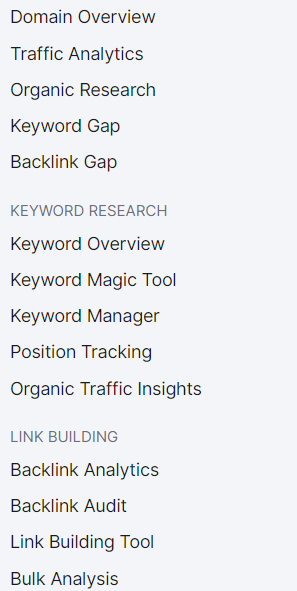
Step 10: Continuous Optimization
On-page SEO is an ongoing process. Regularly use SEMrush’s On-Page SEO tool to audit new and existing pages, keeping your content optimized as search algorithms and trends evolve.
4: Screaming Frog SEO Spider OnPage SEO tool and How to use It
Screaming Frog SEO Spider is a powerful desktop tool that can perform technical audits of websites, including on-page SEO analysis. It helps you identify various issues on your website that might be affecting its performance in search engine rankings. Here’s a step-by-step guide on how to use Screaming Frog SEO Spider for on-page SEO analysis:
Step 1: Download and Install Screaming Frog SEO Spider

- Visit the Screaming Frog website and download the SEO Spider tool.
- Install the tool on your computer by following the installation instructions.
Step 2: Launch Screaming Frog SEO Spider
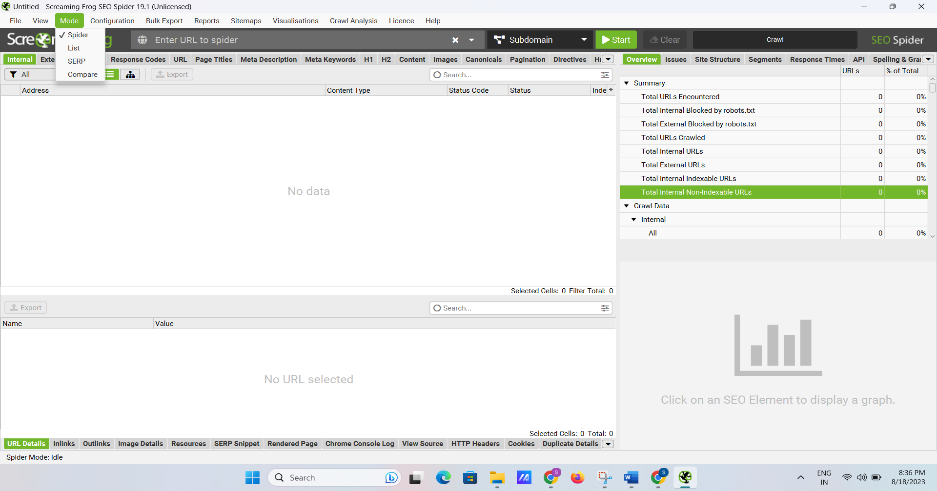
Open the SEO Spider tool after installation.
You’ll see a blank window with a top menu. Click on “Mode” and select “Spider” to start crawling a website.
Step 3: Configure Crawling Settings

- Click on “Configuration” in the top menu to set up your crawling preferences.
- Under “Spider,” enter the URL of the website you want to crawl.
- Adjust settings such as “Spider” mode (crawl all, crawl only inlinks, etc.), “User-Agent,” and other preferences.
Step 4: Start the Crawling Process

Click on the “Start” button to begin the crawling process. The tool will start visiting the pages on the website and gathering data.
Step 5: Review On-Page SEO Analysis

- Once the crawl is complete, you’ll see a list of URLs on the left side of the tool’s window.
- Click on a specific URL to see its details in the main window. You’ll find information about on-page elements such as title tags, meta descriptions, header tags, images, and more.
Step 6: Address On-Page SEO Issues
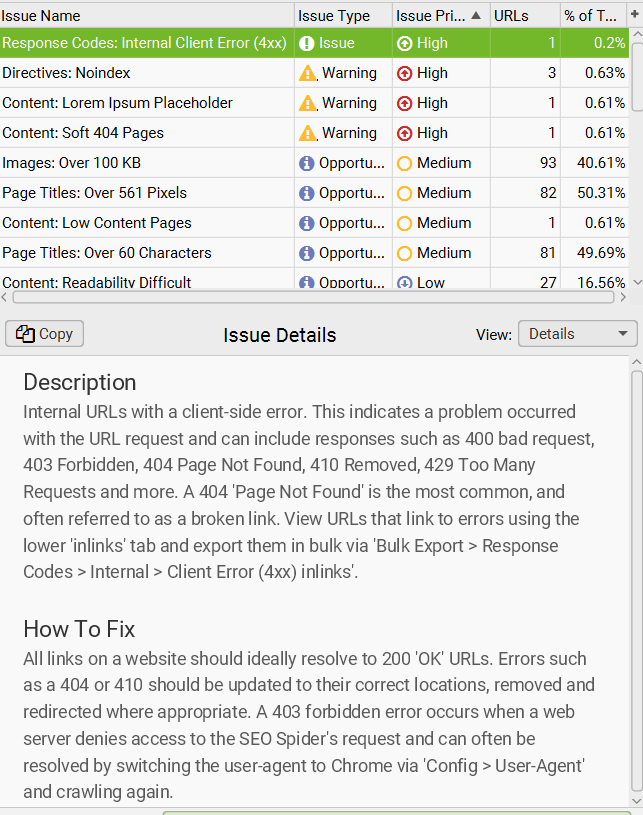
- Review the information provided by the tool and identify any on-page SEO issues such as missing title tags, duplicate content, broken links, and other technical issues.
- Use the insights gained from the analysis to make improvements to your website’s on-page elements.
Step 7: Export and Analyze Data

You can export the data for further analysis and reporting. Click on “Bulk Export” in the top menu to export various reports such as titles, meta descriptions, and more.
Step 8: Utilize Additional Features

Screaming Frog SEO Spider offers various advanced features, including the ability to integrate with Google Analytics and Search Console, generate XML sitemaps, and more. Explore these features to enhance your analysis.
Step 9: Regular Auditing
On-page SEO analysis is an ongoing process. Regularly use Screaming Frog SEO Spider to audit your website and make sure that new content is optimized and technical issues are addressed.
5: Google Search Console for OnPage SEO and How to use It
Google Search Console (formerly known as Google Webmaster Tools) is a free tool provided by Google that allows you to monitor and optimize your website’s presence in Google’s search results. It provides valuable insights into how Google views and indexes your site, offering data and recommendations that can be crucial for effective on-page SEO. Here’s a step-by-step guide on how to use Google Search Console for on-page SEO:
Step 1: Set Up Your Website in Google Search Console
- Go to the Google Search Console website (https://search.google.com/search-console/).
- Sign in with your Google account.
- Click on the “Add Property” button and enter your website’s URL.
Step 2: Verify Ownership
- Choose a verification method provided by Google (HTML file upload, HTML tag, Google Analytics, etc.).
- Follow the instructions to verify ownership of your website. Once verified, you’ll gain access to your Search Console dashboard.
Step 3: Navigate to the Performance Report
- In the Search Console dashboard, click on “Performance” on the left-hand menu.
- This report provides valuable data on search queries, clicks, impressions, click-through rates (CTR), and average position for your website in Google’s search results.
Step 4: Analyze Performance Data
- Use the filters and date range options to analyze your website’s performance. Focus on the queries that are driving the most clicks, impressions, or are underperforming.
- You can also analyze performance data for specific pages of your website.
Step 5: Optimize Content with Search Analytics
Use the data in the Performance report to identify opportunities for optimizing your content. Look for keywords that you’re ranking well for but have a low CTR. Adjust your titles and meta descriptions to make them more compelling.
Step 6: Explore the Coverage Report
In the left-hand menu, click on “Coverage.” This report highlights any indexing issues Google encountered while crawling your website.
Step 7: Address Indexing Issues
- If you see errors or warnings in the Coverage report, click on them to get more information. This might include pages that couldn’t be indexed, pages with noindex tags, or other issues.
- Address these issues to ensure that your content is properly indexed by Google.
Step 8: Check the Sitemaps Section
In the left-hand menu, click on “Sitemaps.” Here, you can submit your website’s sitemap to help Google better understand the structure of your site.
Step 9: Use the URL Inspection Tool
- Click on “URL Inspection” in the left-hand menu.
- Enter a specific URL from your website and click “Enter.” This tool provides insights into how Google sees the page and whether it’s indexed.
Step 10: Monitor and Iterate
- Regularly review the performance, coverage, and other reports in Google Search Console.
- Continuously optimize your content based on the insights you gain from these reports.
6: Ahrefs Site Audit Tool & How to do It
Using Ahrefs’ On-Page SEO tool can greatly enhance your website’s optimization efforts. Here’s a step-by-step guide on how to effectively use this tool:
Step 1: Log in to Ahrefs
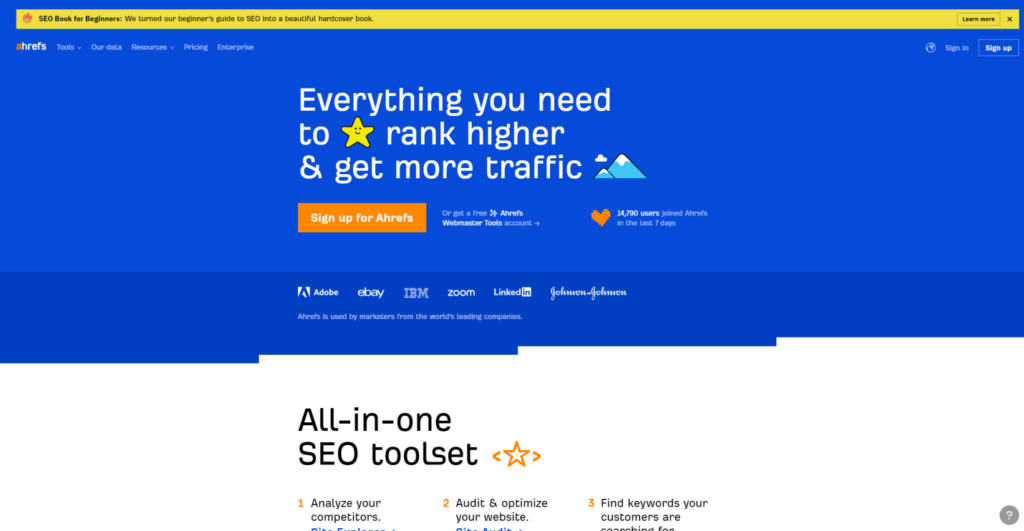
- Visit the Ahrefs website and log in to your account. If you don’t have an account, you’ll need to sign up for a subscription.
Step 2: Access the On-Page SEO Tool
- Once logged in, you’ll be on the Ahrefs dashboard. On the top menu, find and click on “Site Audit” under the “Tools” section.
Step 3: Set Up a New Site Audit Project

- Click on the “New Project” button to set up a new site audit project.
- Enter your website’s URL and a name for the project. Choose the appropriate settings for the audit, such as crawl depth and frequency.
Step 4: Wait for the Audit to Complete
Ahrefs will start crawling your website to gather data. Depending on the size of your website, this may take some time. You can navigate away from the page, and Ahrefs will notify you when the audit is complete.
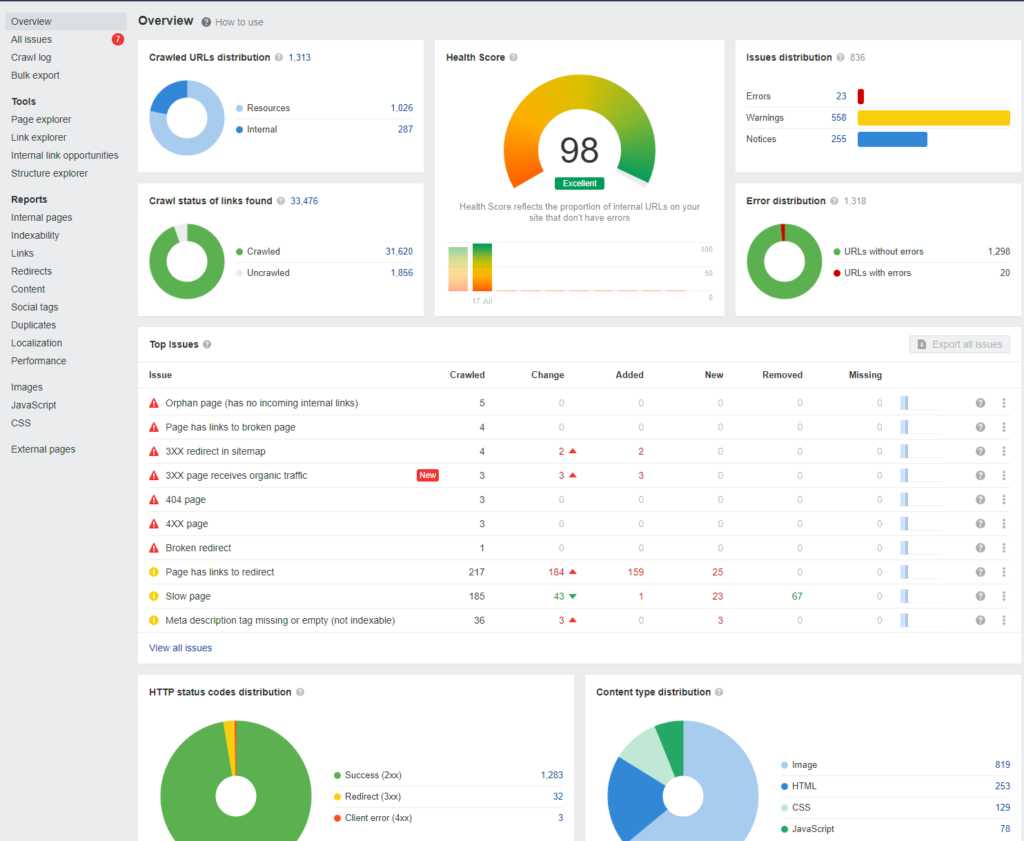
Step 5: Access the On-Page SEO Tool
After the audit is complete, go back to the “Site Audit” section. You’ll see a list of your projects. Click on the project you created.
Step 6: Explore On-Page SEO Recommendations
- In your project, you’ll see various sections, including “Health Score,” “Issues,” “Warnings,” and “Notices.” The “Issues” section is where you’ll find on-page SEO recommendations.
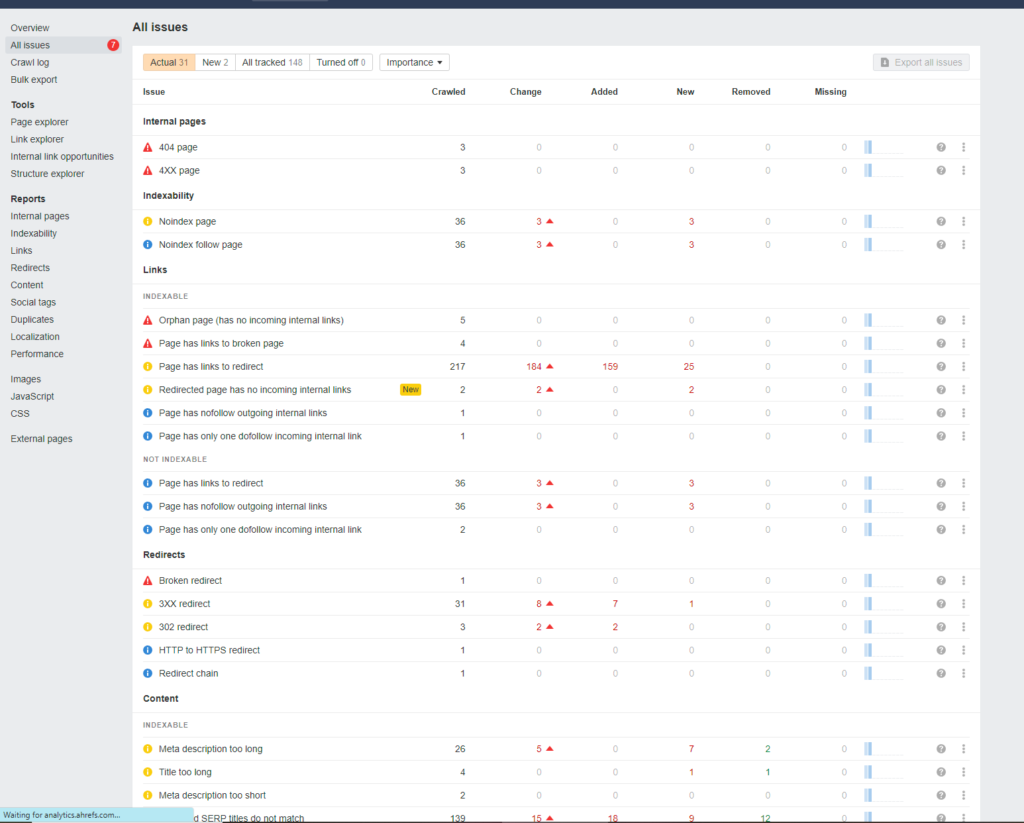
Step 7: Address On-Page SEO Issues
- Click on the “Issues” section to see a list of on-page SEO issues Ahrefs has identified on your website. These can include missing meta tags, duplicate content, broken links, and more.
- Review each issue and click on it to get more details. Ahrefs will often provide insights on why the issue is important and how to fix it.
Step 8: Monitor Progress
- As you make changes to address the identified issues, you can re-run the audit to see how your website’s on-page SEO health improves over time.
Step 9: Utilize Additional Features
- Ahrefs’ On-Page SEO tool offers other features, such as tracking your website’s performance in search rankings and exploring content gaps. Take advantage of these features to further optimize your website.
Step 10: Learn and Adapt
- Regularly use the Ahrefs On-Page SEO tool to monitor your website’s performance and address any new issues that arise. Continuously learning and adapting based on the insights from the tool will help you maintain a strong on-page SEO strategy.
Remember that while Ahrefs’ On-Page SEO tool provides valuable insights, it’s essential to have a good understanding of SEO principles and best practices to effectively implement the recommendations and make the most out of the tool’s capabilities.
How Much do SEO Tools Cost?
The cost of SEO tools can vary widely depending on factors such as the features offered, the size of your business, the scale of your SEO efforts, and the specific tool provider. Some tools offer free versions with limited features, while others offer more robust paid versions with advanced functionalities.
Here’s a general overview of the cost ranges for different types of SEO tools:
- Free SEO Tools: Many basic SEO tools offer free versions or trials. These tools are typically limited in terms of features and usage. Examples include Google Analytics, Google Search Console, Google Keyword Planner, and MozBar.
- Entry-Level Paid Tools: These tools offer more features and capabilities compared to free options. Prices for entry-level paid tools can range from $20 to $100 per month. Examples include Ubersuggest, SEMrush’s lower-tier plans, and Ahrefs’ Lite plan.
- Mid-Range Paid Tools: These tools provide more advanced features and are suitable for businesses with more extensive SEO needs. Prices for mid-range paid tools typically range from $100 to $300 per month. Examples include higher-tier plans from SEMrush, Ahrefs, and Moz.
- Advanced SEO Suites: Comprehensive SEO suites that offer a wide range of features and tools for in-depth analysis and optimization. Prices for advanced SEO suites can range from $300 to $1,000 or more per month. Examples include SEMrush’s Guru and Business plans, Ahrefs’ Standard and Advanced plans, and Moz Pro.
- Enterprise-Level Tools: These tools cater to larger businesses and agencies with extensive SEO requirements. Prices for enterprise-level tools can exceed $1,000 per month, depending on the features and scale. Custom pricing is often offered for these plans.
It’s important to note that some tools may offer discounts for annual billing or have different pricing tiers based on factors like the number of users or tracked keywords. Additionally, the cost of SEO tools is an investment that should be evaluated based on your business’s needs, goals, and the value the tools bring to your optimization efforts.
When considering a tool, assess its features, reputation, user reviews, and whether it aligns with your specific requirements. Most tools also offer free trials, so you can test them out to determine if they meet your needs before committing to a paid plan.
How to Choose the Best OnPage SEO Tool?
Choosing the best On-Page SEO tool for your needs requires careful consideration of your specific requirements, budget, and the features offered by different tools.
Here’s a step-by-step guide to help you choose the best On-Page SEO tool:
- Identify Your Needs: Start by understanding your goals and needs. Are you looking for a tool to optimize content, analyze technical aspects, monitor rankings, or all of the above? Consider factors such as the size of your website, the number of pages you need to optimize, and your familiarity with SEO practices.
- Define Your Budget: Determine how much you’re willing to invest in an On-Page SEO tool. Different tools offer various pricing plans, so having a clear budget range will help you narrow down your options.
- Research Tool Options: Research and compile a list of On-Page SEO tools that align with your needs and budget. Look for reputable tools with positive user reviews and a track record of delivering effective results.
- Evaluate Features: Carefully review the features offered by each tool. Consider essential features such as keyword analysis, content optimization, technical auditing, reporting, competitor analysis, and more. Make a list of features that are non-negotiable for your optimization efforts.
- Check Ease of Use: Choose a tool with a user-friendly interface that you and your team can easily navigate. A tool that’s intuitive and doesn’t require extensive technical expertise can save you time and frustration.
- Assess Accuracy and Reliability: Check if the tool’s data and recommendations are accurate and reliable. Look for tools that provide up-to-date insights based on the latest search engine algorithms and best practices.
- Trial Periods: Many On-Page SEO tools offer free trials or money-back guarantees. Take advantage of these trial periods to test the tool’s features, interface, and overall performance before committing to a paid plan.
- Customer Support: Consider the level of customer support provided by the tool’s company. Access to responsive customer support can be crucial if you encounter technical issues or need assistance with using the tool effectively.
- Integration and Compatibility: Check if the tool integrates with other software or platforms you’re already using, such as content management systems (like WordPress), Google Analytics, or other SEO tools. Compatibility can streamline your workflow.
- Scalability: Consider whether the tool can accommodate your future needs as your website and optimization efforts grow. Choose a tool that can scale with your business.
- Reviews and Recommendations: Read reviews and recommendations from other users or SEO experts. This can provide valuable insights into the tool’s strengths and weaknesses from real-world experiences.
- Training and Resources: Evaluate the availability of training materials, tutorials, and resources provided by the tool’s company. Learning resources can help you maximize the tool’s capabilities.
- Long-Term Commitment: Choosing an On-Page SEO tool is a long-term commitment. Make sure the tool aligns with your long-term goals and can provide consistent value over time.
By carefully evaluating these factors, you can choose the On-Page SEO tool that best suits your requirements and empowers you to optimize your website effectively for better search engine rankings and user engagement.
Searching for SEO Services?
RankON Technologies is one of the best SEO companies in India. Visit our SEO packages now and see the differences. We offer outsourced SEO, Local SEO Services, Ecommerce SEO services and small business SEO services at very best prices.
Get in Touch!SEO Packages











